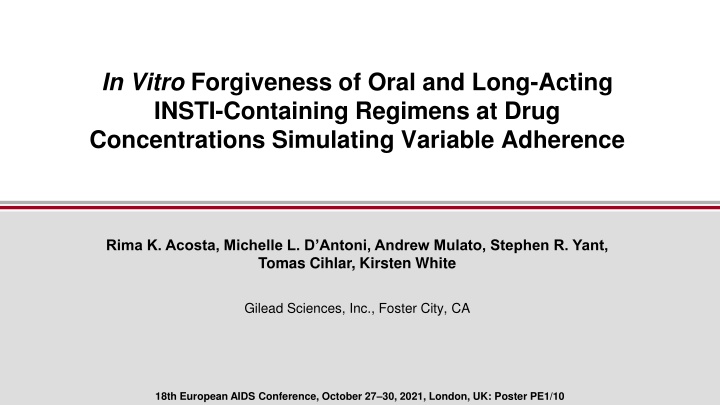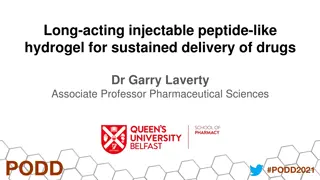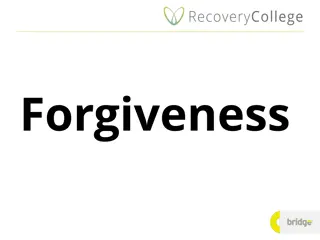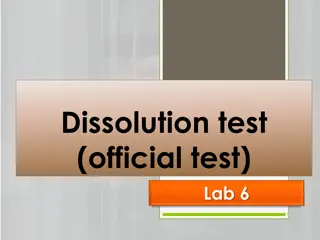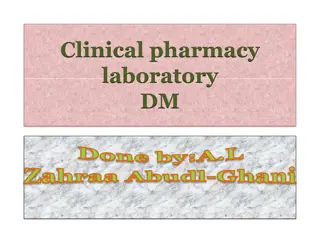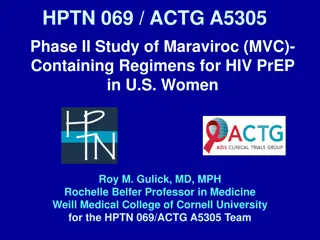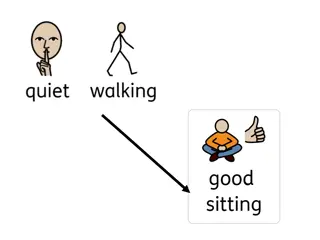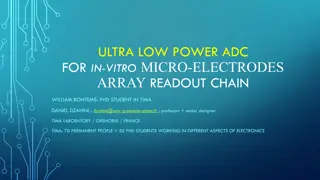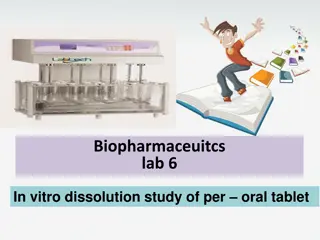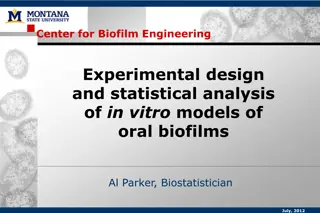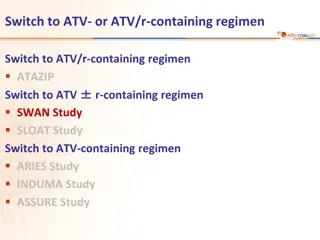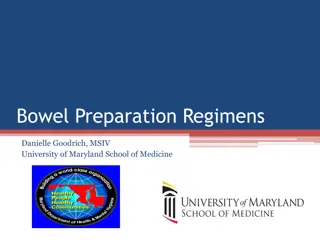In Vitro Forgiveness of Oral and Long-Acting INSTI-Containing Regimens at Drug Concentration Simulating Variable Adherence
EACS guidelines recommend daily oral regimens for HIV-1 treatment, but lapses in adherence can result in virologic failure. This study explores forgiveness of different regimens at variable drug concentrations. Long-acting options may offer alternatives to daily oral medications. Antiviral pharmacokinetics of missed doses are also analyzed for various drug combinations.
Download Presentation

Please find below an Image/Link to download the presentation.
The content on the website is provided AS IS for your information and personal use only. It may not be sold, licensed, or shared on other websites without obtaining consent from the author.If you encounter any issues during the download, it is possible that the publisher has removed the file from their server.
You are allowed to download the files provided on this website for personal or commercial use, subject to the condition that they are used lawfully. All files are the property of their respective owners.
The content on the website is provided AS IS for your information and personal use only. It may not be sold, licensed, or shared on other websites without obtaining consent from the author.
E N D
Presentation Transcript
In Vitro Forgiveness of Oral and Long-Acting INSTI-Containing Regimens at Drug Concentrations Simulating Variable Adherence Rima K. Acosta, Michelle L. D Antoni, Andrew Mulato, Stephen R. Yant, Tomas Cihlar, Kirsten White Gilead Sciences, Inc., Foster City, CA 18th European AIDS Conference, October 27 30, 2021, London, UK: Poster PE1/10
Introduction EACS guidelines for initial treatment of HIV-1 infection recommend daily oral regimens anchored by an INSTI plus 1 or 2 NRTIs, including the STR of BIC/FTC/TAF, the combination of DTG+FTC/TAF, and the STR of DTG/3TC1 The 2-drug daily oral STR of DTG/RPV is approved for PWH switching ARV regimens Recently, the LA INJ regimen CAB+RPV was approved for monthly and 2-month dosing in some countries Lapses in adherence to daily ARV drugs can lead to virologic failure and development of drug resistance, but regimens will have distinct durations of forgiveness (avoiding viral rebound and resistance in the setting of suboptimal adherence) Long-acting regimens may be beneficial for those who want alternatives to daily oral medications, but they cannot be self-administered and there is potential for resistance development associated with low drug exposure, inconsistent dosing, preexisting drug resistance, or HIV-1 subtype2 Previous in vitro experiments have shown that when using an inoculum of wild-type or M184V virus, BIC+FTC+TAF was better at preventing viral breakthrough and emergent drug resistance than DTG+3TC3 In vitro viral breakthrough experiments should be analyzed comparatively; clinical trials assessing the impact of missed doses of these ARV combinations have not been conducted 3TC, lamivudine; ARV, antiretroviral; BIC, bictegravir; CAB, cabotegravir; DTG, dolutegravir; FTC, emtricitabine; INSTI, integrase strand transfer inhibitor; LA INJ, long-acting injectable; NNRTI, nonnucleoside reverse transcriptase inhibitor; NRTIs, nucleoside reverse transcriptase inhibitors; PWH, people with HIV; RPV, rilpivirine; STR, single-tablet regimen; TAF, tenofovir alafenamide. 2
Antiviral Pharmacokinetics of Daily Oral Regimens With 1 4 Consecutive Missed Doses Optimal Adherence Cmin Cmin Cmin 1 dose Constant, established Cmin Cmin 2 doses Cmin 3 doses Cmin 4 doses Missed dose Missed dose Missed dose Missed dose ARV dose ARV dose 0 1 2 3 4 5 0 1 2 3 4 5 Time, d Time, d Missing daily oral ARV doses results in a predictable decrease of systemic exposures to each drug in the regimen based on its established clinical half-life (t1/2) Cmin, trough concentration. 3
Objectives To understand relative time to in vitro viral breakthrough and resistance barrier using simulated human drug exposures at either full or suboptimal treatment adherence to BIC+FTC+TAF, DTG+FTC+TAF, DTG+3TC, DTG+RPV, and CAB+RPV LA INJ 4
Methods: Figure 1. In Vitro Viral Breakthrough Selections* Every 3 4 d: + MT-2 cells HIV-1 IIIb CPE scoring Plating Maintain culture for 5 wk BIC+FTC+TAF DTG+FTC+TAF DTG+3TC or or or Deep sequence supernatant virus at time of breakthrough DTG+RPV CAB+RPV LA INJ or Drug combinations; replicates for each condition in 24-well plate Split culture into new plate with fresh media/drug *MT-2 cells were infected with HIV-1 IIIb; infected cells were cultured in presence of fixed concentrations of BIC+FTC+TAF, DTG+FTC+TAF, DTG+3TC, DTG+RPV, and CAB+RPV, split every 3 4 d with fresh media containing drug, and monitored for viral breakthrough by cytopathic effect (CPE) for up to 5 wk; supernatants containing breakthrough virus were collected and stored. 5
Methods Simulation of drug Cminin vitro: To simulate clinical Cmin, pharmacokinetic data from participants in clinical trials were used and corrected for human plasma protein binding for BIC, DTG, RPV, and CAB For the NRTIs FTC, 3TC, and TAF, intracellular active metabolite concentrations were used Simulation of missed daily oral doses: To simulate 2 and 4 consecutive missed doses (Cmin 2 and Cmin 4, respectively), drug concentrations were adjusted by plasma t1/2 for BIC, DTG, and RPV, and by intracellular t1/2 for NRTIs (TAF, FTC, and 3TC) Cmin X doses were determined as Cmin 0.524x/t1/2 Genotypic analyses: Each viral breakthrough supernatant was sequenced by next-generation sequencing (SEQ-IT GmbH & Co.KG, Kaiserslautern, Germany) and mutations were reported if present at 2% A bioinformatics filter was used to remove APOBEC-mediated G-to-A hypermutated sequences Mutations were observed between 2.1% and 69.3% per culture 6
Results: Table 1. Drug Concentrations for Cell Culture Equivalents LA INJ Regimen Components of Daily Oral Regimens FTC TAF 200 25 247.2 534.5 0.096 0.008 388 15 1.0 1.0 37 116 388 15 158 11 64.2 8.5 q4wk (q1mo) CAB 400 q8wk (q2mo) CAB 600 BIC 50 449.4 2.61 5808 43.6 17 133 19 2.7 DTG 50 419.4 1.11 2515 27.5 14 91 8.5 0.8 3TC 300 229.3 0.042 265 1.0 17.5 265 40 5.9 RPV 25 366.4 0.08 218 32 50 6.8 3.5 1.8 RPV 600 RPV 900 Clinical dose, mg* Molecular weight, g/mol Clinical Cmin, g/mL Clinical Cmin, nM Human serum shift t1/2, h CCE Cmin, nM Cmin 2 Cmin 4 6365 74 258 32 3602 74 176 32 86 8.1 49 5.5 *Clinical doses of BIC, FTC, and TAF in STR of B/F/TAF; DTG, 3TC, and RPV in STRs of DTG/3TC and DTG/RPV4-6; and CAB and RPV in CAB/RPV injectables7; BIC, DTG and CAB data generated by standard equilibrium dialysis shift in human serum vs cell culture media8,9; RPV data generated internally and comparable to reported serum shift10; Drug t1/2 for BIC, DTG, FTC- triphosphate (FTC-TP), tenofovir-diphosphate (TFV-DP), 3TC-triphosphate (3TC-TP), and RPV4-8,11-13; Cell culture equivalent (CCE) dose is clinical Cmin/human serum shift ratio. BIC, DTG, RPV, and CAB concentrations were calculated using their human plasma clinical Cmin according to their prescribing information, and adjusted for human plasma protein binding (Table 1)4-10 TAF Cmin used the active metabolite TFV-DP at its physiologic concentration in peripheral blood mononuclear cells from TAF- treated individuals14,15 FTC and 3TC concentrations were set at their human plasma-free adjusted Cmin11-13 7
Table 2. Mechanisms of Forgiveness and Barrier to Resistance for Daily Oral Combinations Mechanisms Long plasma or intracellular t1/2, h BIC or DTG FTC-TP or 3TC-TP TFV-DP RPV IN/DNA dissociation t1/2 for BIC or DTG Combination antiviral activity BIC or DTG + FTC or 3TC BIC+TAF or DTG+TAF TFV+FTC DTG+RPV TFV-chain-termination stabilized by dead- end complex with FTC-TP Phenotype of M184V BIC, DTG, or RPV FTC or 3TC TFV (TAF) No. of mutations required to confer resistance BIC, DTG, or TAF RPV FTC or 3TC BIC+FTC+TAF DTG+FTC+TAF DTG+3TC DTG+RPV 17 37 116 na 132 14 37 116 na 71 78 14 17.5 na na 71 78 14 na na 50 Drug Levels 71 78 Synergy Synergy Synergy na Synergy Synergy Synergy na Synergy na na na na na na Synergy and Mechanisms of Synergy Synergy Increased TFV activity Increased TFV activity na na Sensitive Resistant Hypersensitive Sensitive Resistant Hypersensitive Sensitive Resistant na Sensitive na na Resistance Profile High na Low High na Low High na Low High Genetic Barrier to Resistance Low medium na IN, integrase; na, not applicable. 8
Figure 2. Time to Viral Breakthrough CAB+RPV q1mo CAB+RPV q2mo DTG+3TC DTG+FTC+TAF DTG+RPV BIC+FTC+TAF Long-Acting Injectable Oral Daily Cmin Cmin Cmin 2 Cmin 4 100 100 100 100 36/36 (100%) 80 80 80 80 48/48 (100%) 45/48 (94%) Viral Breakthrough, % 41/60 (68%) 60 60 60 60 18/36 (50%) 40 40 40 40 0/48 0/48 0/48 0/60 0/48 0/48 0/60 20 20 20 20 0/24 0/24 0 0 0 0 0 4 8 11 15 18 23 28 32 35 0 4 8 11 15 18 23 28 32 35 0 4 8 11 15 18 23 28 32 35 0 4 8 11 15 18 23 28 32 35 Time Postinfection, d Time Postinfection, d Time Postinfection, d Time Postinfection, d 25 25 25 25 20/48 (42%) Cultures With Resistance, n* 20 20 20 20 13/60 (22%) 15 15 15 15 10 10 10 10 6/48 (13%) 3/36 (8%) 2/36 (6%) 5 5 5 5 0 0 0 0 4 M184V/I 3 V75I 1 K219R 2 M230I 3 K101E 1 H221Y 4 E138K 1 V90I 1 V90I+V106I+E138K 1 R263K 1 M50I 1 S153F 1 G163R 1 Y181C(RT)+H51Y(IN) 1 E138K(RT)+H51Y(IN) 1 E138K(RT)+Q95R(IN) 1 E138K(RT)+A128T(IN) 2 M184I Emergent Resistance RT Substitutions 1 L74M 2 G140E/R 1 S153F 2 E157K 1 H51Y 1 S153F 2 Q148R 1 G163R 1 R263K 1 L74M +R263K IN 1 M184V(RT) +Q95R(IN) RT+IN *Contained 1 known resistance-associated substitution. RT, reverse transcriptase. The LA INJ combination CAB+RPV prevented viral breakthrough at drug Cmin (monthly and 2-month dosing; Fig 2) 9
Conclusions The INSTI-containing combinations of BIC+FTC+TAF, DTG+FTC+TAF, DTG+3TC, and DTG+RPV had no viral breakthrough with concentrations simulating high adherence Regimen differentiation occurred when multiple missed doses were simulated in vitro; BIC+FTC+TAF had the highest forgiveness and barrier to resistance In vitro viral breakthrough experiments should be analyzed comparatively; controlled clinical trials assessing the impact of missed doses of these ARV combinations have not been conducted The long-acting injectable combination of CAB+RPV had no viral breakthrough at concentrations simulating Cmin for both monthly and 2-month dosing; further studies with CAB+RPV are needed to understand forgiveness during the pharmacokinetic tail of this regimen 10
References 1. EACS. Guidelines Version 10.1; October 2020; 2. Cutrell A, et al. AIDS 2021;35:1333-42; 3. Mulato A, et al. JAIDS 2021;86:369-77; 4. Biktarvy [package insert]. Foster City, CA: Gilead Sciences, Inc.; revised 9/21; 5. Dovato [package insert]. Research Triangle Park, NC: ViiV Healthcare; 3/21; 6. Juluca [package insert]. Research Triangle Park, NC: ViiV Healthcare; 3/21; 7. Cabenuva [package insert]. Research Triangle Park, NC: Viiv Healthcare; 1/21; 8. Margolis D, et al. Lancet 2017;390:1499-510; 9. Tsiang M, et al. Antimicrob Agents Chemother 2016;60:7086-97; 10. European Medicines Agency. CHMP assessment report: Edurant; 9/22/11; 11. Dickinson L, et al. Antimicrob Agents Chemother 2015;5910:6080-6; 12. Else LJ, et al. Antimicrob Agents Chemother 2011;56:1427-33; 13. Yuen GJ, et al. Antimicrob Agents Chemother 2004;48:176-82; 14. Callebaut C, et al. PLoS One 2017;12:e0169948; 15. Custodio JM, et al. Antimicrob Agents Chemother 2016;60:5235-4. 11
Acknowledgments The authors thank Alex Thielen and Martin Daeumer at Seq-IT, and Ross Martin and Silvia Chang at Gilead for deep-sequence analyses. This study was funded by Gilead. 12
